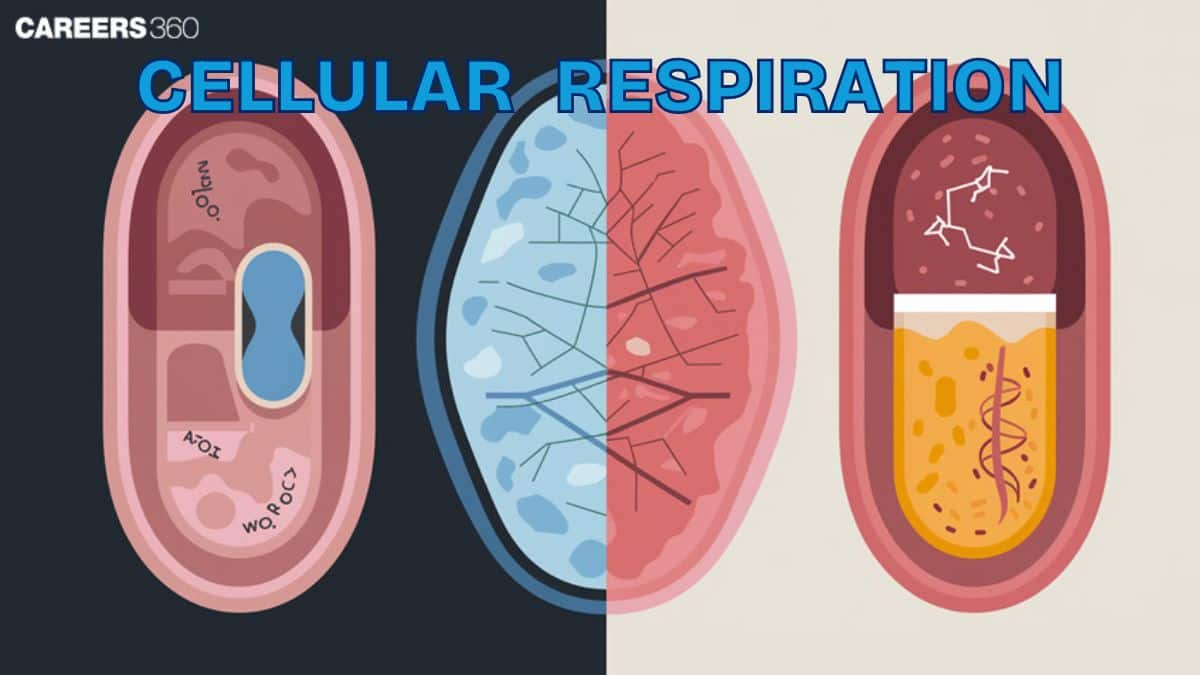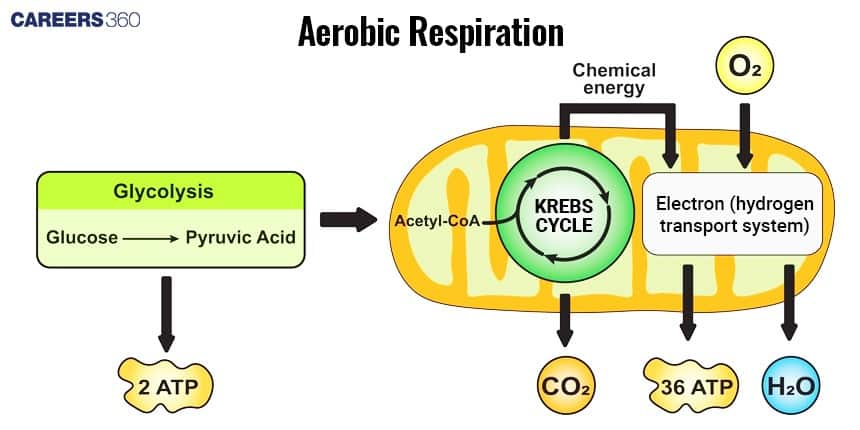Cellular Respiration, Cellular Respiration: Aerobic Vs Anaerobic: Anaerobic And Aerobic Respiration
Cellular respiration is the multistep biochemical process through which cells extract ATP from glucose using enzymes and metabolic pathways. It includes glycolysis, Krebs cycle, and the electron transport chain, occurring in the cytoplasm and mitochondria. Understanding aerobic vs anaerobic respiration is essential for NEET Biology and human physiology.
This Story also Contains
- What Is Cellular Respiration?
- Types Of Cellular Respiration
- Aerobic Respiration
- Anaerobic Respiration
- Stages of Aerobic Respiration
- Anaerobic Respiration Pathways
- Aerobic vs Anaerobic Respiration (Table)
- Significance of Cellular Respiration
- Cellular Respiration NEET MCQs (With Answers & Explanations)

What Is Cellular Respiration?
Cellular respiration is the biochemical process by which glucose is converted into ATP, the key form of energy in cells, in a series of steps involving metabolic pathways. It is generally the process through which most of the energy that one needs to perform several cellular activities is acquired.
Cellular respiration is the oxidation of sugar that forms both ATP and water as products, with the byproduct being carbon dioxide. It involves three key steps: glycolysis, Krebs cycle, and electron transport chain. It refers to the process through which living organisms obtain energy from food to stay alive, grow, and repair or replace damaged cell structures.
Types Of Cellular Respiration
There are two main types of cellular respiration. These are based on the presence or absence of oxygen.
Aerobic respiration which requires oxygen and the glucose is completely oxidised.
Anaerobic respiration which takes place without oxygen and the glucose is partially oxidised.
Aerobic Respiration
Aerobic respiration is a process which requires oxygen and the final product is that glucose is completely broken down into carbon dioxide, water, and ATP. This type of respiration is a common occurrence. It can be represented by the equation:
Glucose + O2 → Water + CO2 + Energy
Anaerobic Respiration
Anaerobic respiration takes place in the absence of oxygen and involves the partial breakdown of glucose. Some other compounds are also formed in addition to carbon dioxide. This type of respiration is of rare occurrence but common in microorganisms like yeasts. It can be represented by the equation:
Glucose → Lactic acid + Small amount of energy
Stages of Aerobic Respiration
The detailed stages are given below:
Glycolysis
Location: Cytoplasm
Process: Breakdown of glucose into pyruvate
Products: ATP and NADH
Krebs Cycle
Location: Mitochondrial matrix
Process: Oxidation of Acetyl-CoA
Products: NADH, FADH2, and ATP
Electron Transport Chain
Location: Inner mitochondrial membrane
Process: Oxygen acts as the final electron acceptor, forming water
Products: Proton gradient and ATP synthesis
Efficiency: High - 36-38 ATP per glucose molecule

Anaerobic Respiration Pathways
The types of anaerobic respiration are:
Lactic Acid Fermentation
Occurs in: Muscle cells
Process: Pyruvate converted to lactic acid
Significance: Regeneration of NAD+
Alcoholic Fermentation
Occurs in: Yeast and some bacteria
Process: Pyruvate converted to ethanol and CO2
Significance: Regeneration of NAD+
ATP Yield: Lower (about 2 ATP per glucose molecule)
Aerobic vs Anaerobic Respiration (Table)
The difference between aerobic and anaerobic respiration includes:
Feature | Aerobic Respiration | Anaerobic respiration |
Oxygen Requirement | Requires oxygen | Does not require oxygen |
ATP Yield | High (36-38 ATP) | Low (2 ATP) |
End Products | CO2 and H2O | Lactic acid or Ethanol and CO2 |
Location | Cytoplasm + Mitochondria | Cytoplasm |
Efficiency | More efficient | Less Efficient |
Significance of Cellular Respiration
The details are given below:
Maintains sustained activity in multicellular organisms.
Required in complex organisms to perform energy-consuming activities.
Useful in low oxygen conditions where aerobic respiration cannot be performed.
Forms the base of industrial processes of fermentation, e.g., brewing and baking.
Cellular Respiration NEET MCQs (With Answers & Explanations)
Important topics for NEET are:
Stages of Aerobic respiration
Types of Anaerobic respiration
Aerobic vs Anaerobic respiration
Practice Questions for NEET
Q1. Life without air would be
Reductional
Free from oxidative damage
Impossible
Anaerobic
Correct answer: 4) Anaerobic
Explanation:
Anaerobic means 'in the absence of molecular oxygen', so life without air would be anaerobic. The atmosphere of Earth at the time of the origin of life was without free oxygen atoms, so the primitive atmosphere was reducing. In such an environment, early organisms likely relied on anaerobic processes like fermentation for energy production. This condition set the stage for the evolution of aerobic organisms once oxygen became more abundant in Earth's atmosphere.
Hence, the correct answer is option 4) Anaerobic.
Q2. The ultimate electron acceptor of respiration in an aerobic organism is
Cytochrome
Oxygen
Hydrogen
Glucose
Correct answer: 2) Oxygen
Explanation:
Oxygen is the final electron acceptor in the electron transport chain during aerobic respiration.
This process involves the transmission of electrons via a sequence of protein complexes in the mitochondrial membrane, which eventually combine with protons and oxygen to produce water (H2O).
Because of its high electronegativity, oxygen is very good at taking up electrons, which promotes oxidative phosphorylation, which produces ATP.
The electron transport chain would stop working in the absence of oxygen, forcing aerobic organisms to rely on less effective energy-producing mechanisms like fermentation or anaerobic respiration.
Hence, the correct answer is option 2)oxygen.
Q3. Pasteur effect is due to
Change from aerobic to anaerobic
Rapid utilization of ATP
Non-synthesis of ATP
Producing oxygen to anaerobically respiring structure
Correct answer: 4) Producing oxygen to anaerobically respiring structure
Explanation:
Pasteur effect -
Change from anaerobic to aerobic condition decreases the rate of sugar breakdown and CO2 evolution. The Pasteur effect describes how cells shift from anaerobic fermentation to aerobic respiration when oxygen becomes available, resulting in a more efficient energy production process. This transition decreases the need for fermentation, reducing the production of byproducts like ethanol and lactic acid. The increased ATP yield from aerobic respiration supports the cell's energy requirements more effectively than anaerobic metabolism.
Hence, the correct option is 4) Producing oxygen to an anaerobically respiring structure.
Frequently Asked Questions (FAQs)
Difference between aerobic and anaerobic respiration: Aerobic respiration requires oxygen and results in high ATP yield while in the case of anaerobic respiration, it occurs in the absence of oxygen and there is a low ATP yield.
During aerobic respiration, glucose gets completely oxidised into carbon dioxide and water, hence more ATPs are yielded as a result of this process than the partial oxidation occurring in case of anaerobic respiration.
Glycolysis, Krebs cycle, Electron transport chain (ETC).
Muscles undergo lactic acid fermentation wherein pyruvate is converted into lactic acid and NAD+ is regenerated to continue the production of ATP without oxygen during severe exercise.